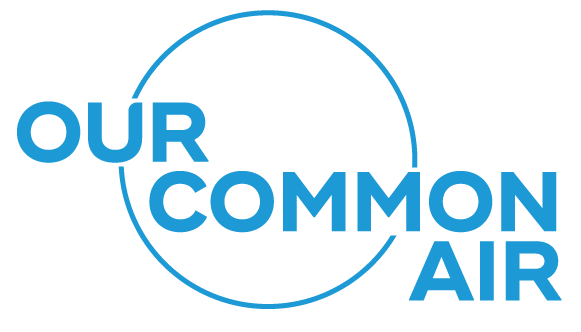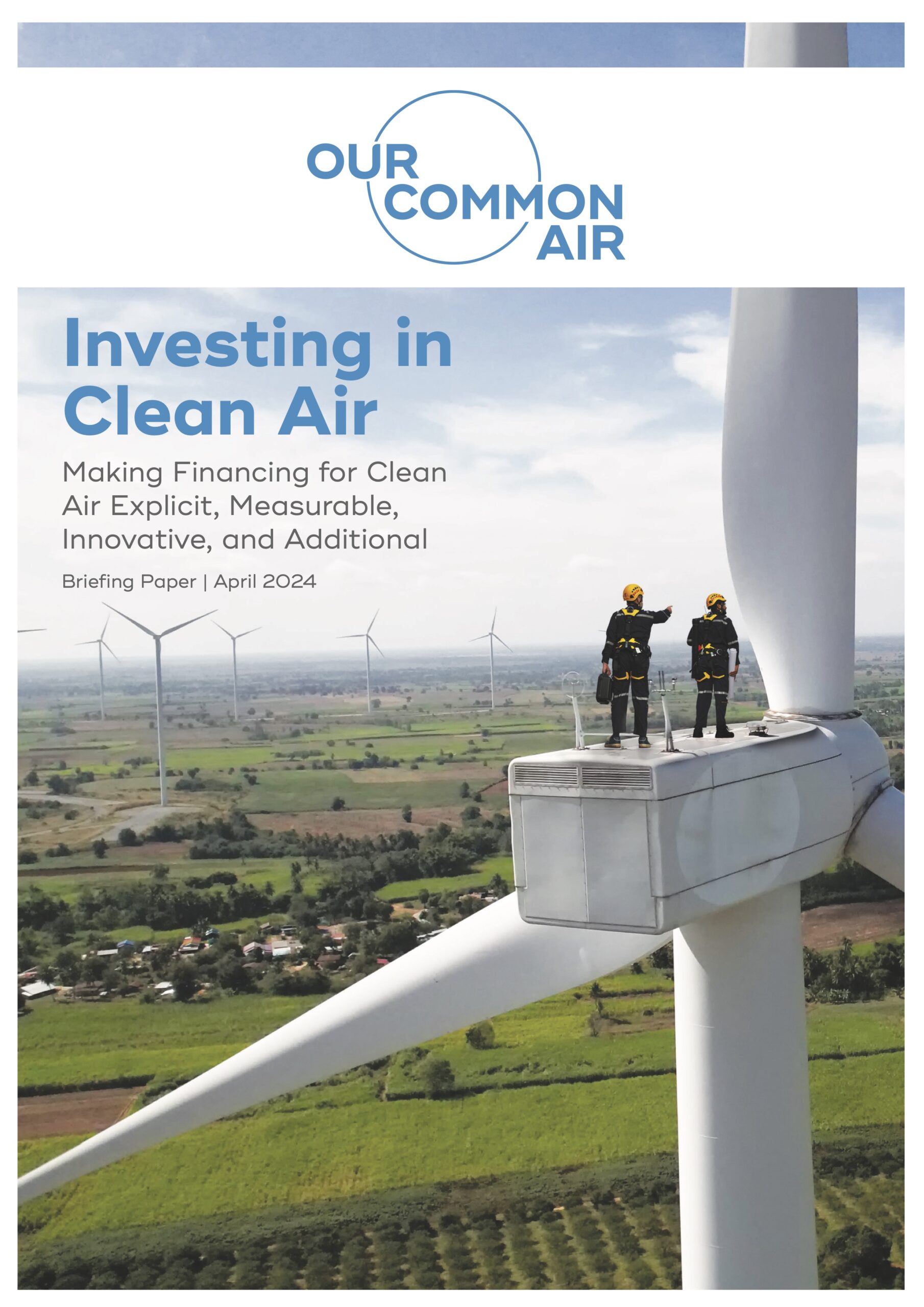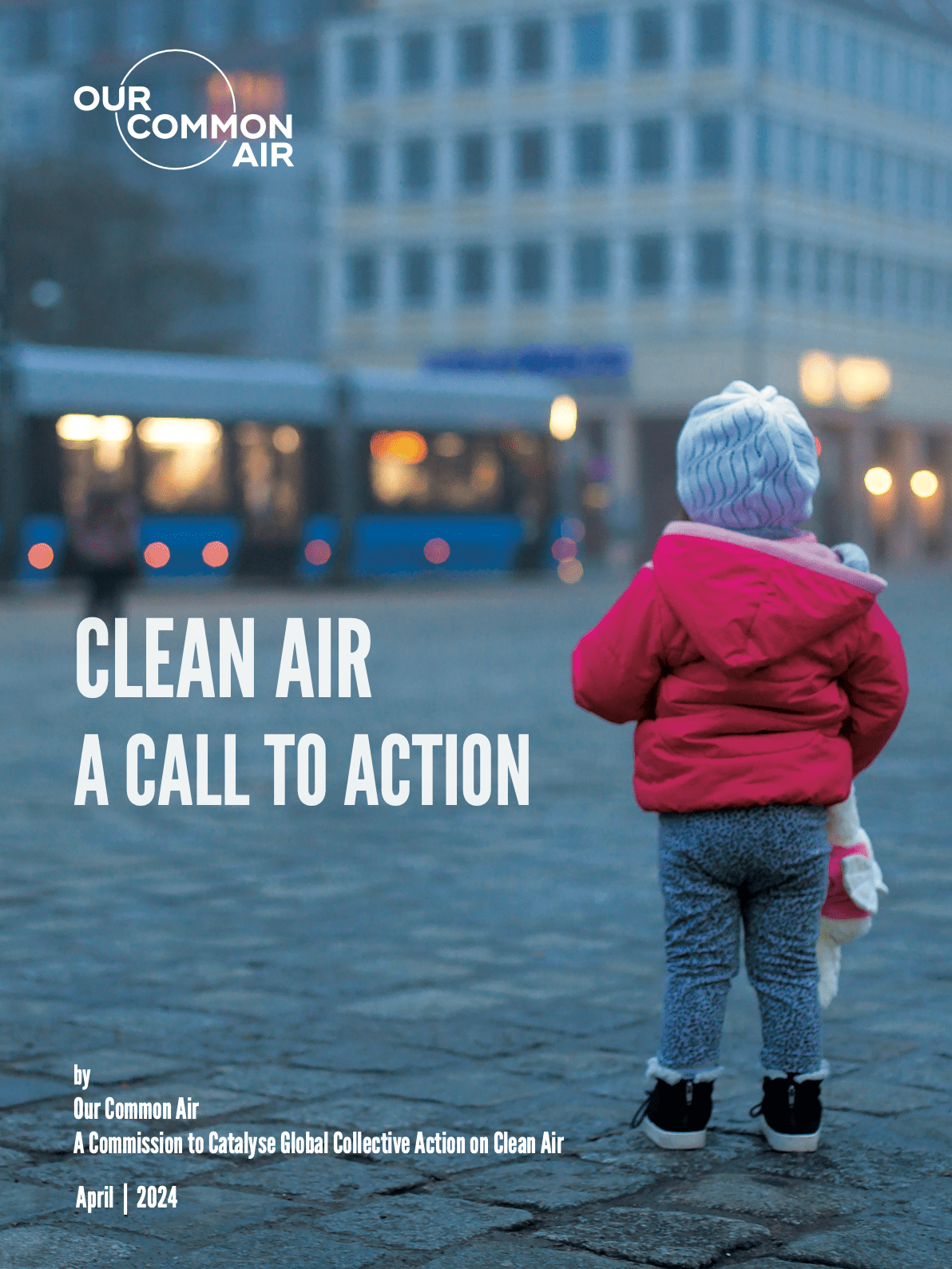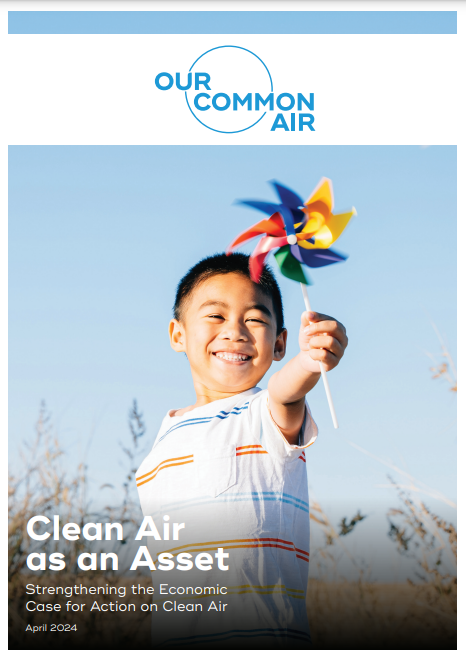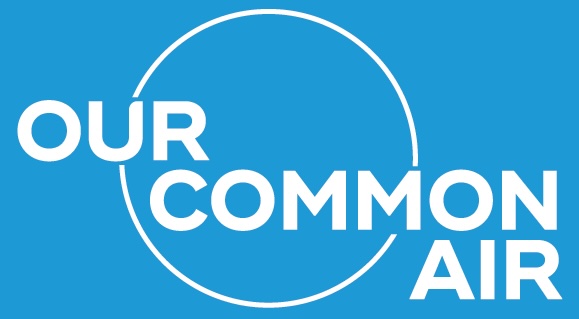
Investing in Clean Air
Making Financing for Clean Air Explicit, Measurable, Innovative, and Additional
A Briefing Paper from Our Common Air
Investing in clean air requires a systemic approach that addresses the root causes of pollution.
April 2024
Authors: Our Common Air
Suggested citation: Our Common Air Commission (2024). Investing in Clean Air: Making Financing for Clean Air Explicit, Measurable, Innovative, and Additional. Available at https://ourcommonair.org/investing-in-clean-air/
Executive Summary
Action on clean air will bring benefits to everyone on the planet, and advance other agendas such as climate change, health, and sustainable development. However, the issue is underfunded and not often enough a stated goal of existing finance flows.
Investing in clean air requires a systemic approach that addresses the root causes of pollution. Polluted air is emitted mainly from residential energy use, power generation, transport, industry, agriculture, biomass burning, wildfires and waste management. These are at the core of the planetary crisis humanity is facing.
Systems transformation is imperative. Energy transition, food systems transformation, cities transformation and circularity movements are critical pathways for fixing the crisis, and will also result in cleaner air. Systems change requires multiple stakeholders working together under a shared vision, supported by unlocked finance.
We recognize clean air as a human right, a societal asset, a part of the global commons and a route to equitable, sustainable development. Therefore, we need to measure and publicly disclose the impacts of human activity on clean air and monitor them on an annual basis, enabling us to steer finance flows.
This paper summarises the current gaps in finance for clean air and lays out a three-part strategy for increasing both the quality and quantity of investment in clean air in ways that also advance climate, health, and development goals. The strategy seeks to align with and leverage existing and growing pools of climate finance and overseas development assistance.
It is important not to compete with other calls for finance. Because cleaner air is a pathway to achieving climate, health, ecosystem, economic, and other gains, its financing will be an integral part of other sectoral and thematic approaches and financing.
The proposed strategy seeks to:
i. Make clean air a development finance priority
ii. Develop metrics for accountability
iii. Use existing funds for clean air and create new financing facilities
In keeping with an approach that seeks systematic shifts and transformations, we urge all stakeholders in the broader finance ecosystem to work together to implement our recommendations.
Why we need a new approach to financing air quality
Despite the huge impact that air pollution has on human and planetary health, very little money is spent tackling the problem. Where there has been investment in cleaner power generation, higher fuel standards, air quality monitoring and stronger scientific understanding, air quality has improved.
However, the reliance on fossil fuels to power growth has led to the illness and death of millions of people worldwide each year, with a particularly costly burden of sickness in the developing world. Neither national resources, nor development assistance, have been deployed at anything like the scale required to secure clean air as an asset for human and ecosystem health, food security, and a stable climate. Nor have governments sufficiently addressed policy weaknesses that lie at the heart of the pollution problem – for example, subsidies and incentives that make it cheaper to pollute than to be clean.
1. Air quality finance lags health, development, climate
The Clean Air Fund’s The State of Global Air Quality Funding 2023 report found that less than 1% of international development funding and an additional 2% of international public climate finance (USD 1.66 billion per year) went to projects focused on tackling outdoor air pollution between 2015 and 2021. An additional 3% of funding prioritised air quality as a co-benefit. Nearly all this money came from just ten development funders, with Japan, the Asian Development Bank, and the Asian Infrastructure Investment Bank as the leaders.1
There are notable funding gaps, with a limited geographic spread. Eighty six percent of development finance for outdoor air quality went to just five countries: China, Philippines, Bangladesh, Mongolia, and Pakistan. Meanwhile, Africa received only 5% (or USD 0.76 billion) of all outdoor air quality funding between 2017-2021, despite being home to five of the top 10 most polluted countries globally on a population weighted basis.2
Most international development funding does not consider air quality among its goals. Some of this money, particularly finance going into reforming sectors that contribute to pollution such as energy, public transport, and agriculture, may in fact contribute to cleaner air, but these impacts are not currently captured or valued in project prioritisation. Other projects, such as new highways, may actually exacerbate air pollution.
Funding from foundations for outdoor air quality improvement rose to an all-time high in 2022, but still represents less than 0.1% of total foundation funding.3
2. Limited variety in funding
The State of Global Air Quality Funding 2023 report also found that 92% of international outdoor air quality finance over the last five years was in the form of loans, with only 8% available as grants. Less than half of these loans (41%) were low-cost or concessional.4
These findings point to at least two areas for improvement. First, the level of grant and low-cost finance available to the set of countries that tend to suffer most from air pollution should be increased. People in low- and middle-income countries, particularly residents in urban areas, often suffer from worse air pollution than those in higher-income countries. The sources of pollution are also often more embedded in everyday household and economic life: biomass fuel for cooking, low-cost sources for industrial energy and small businesses, older engines for freight and transport.
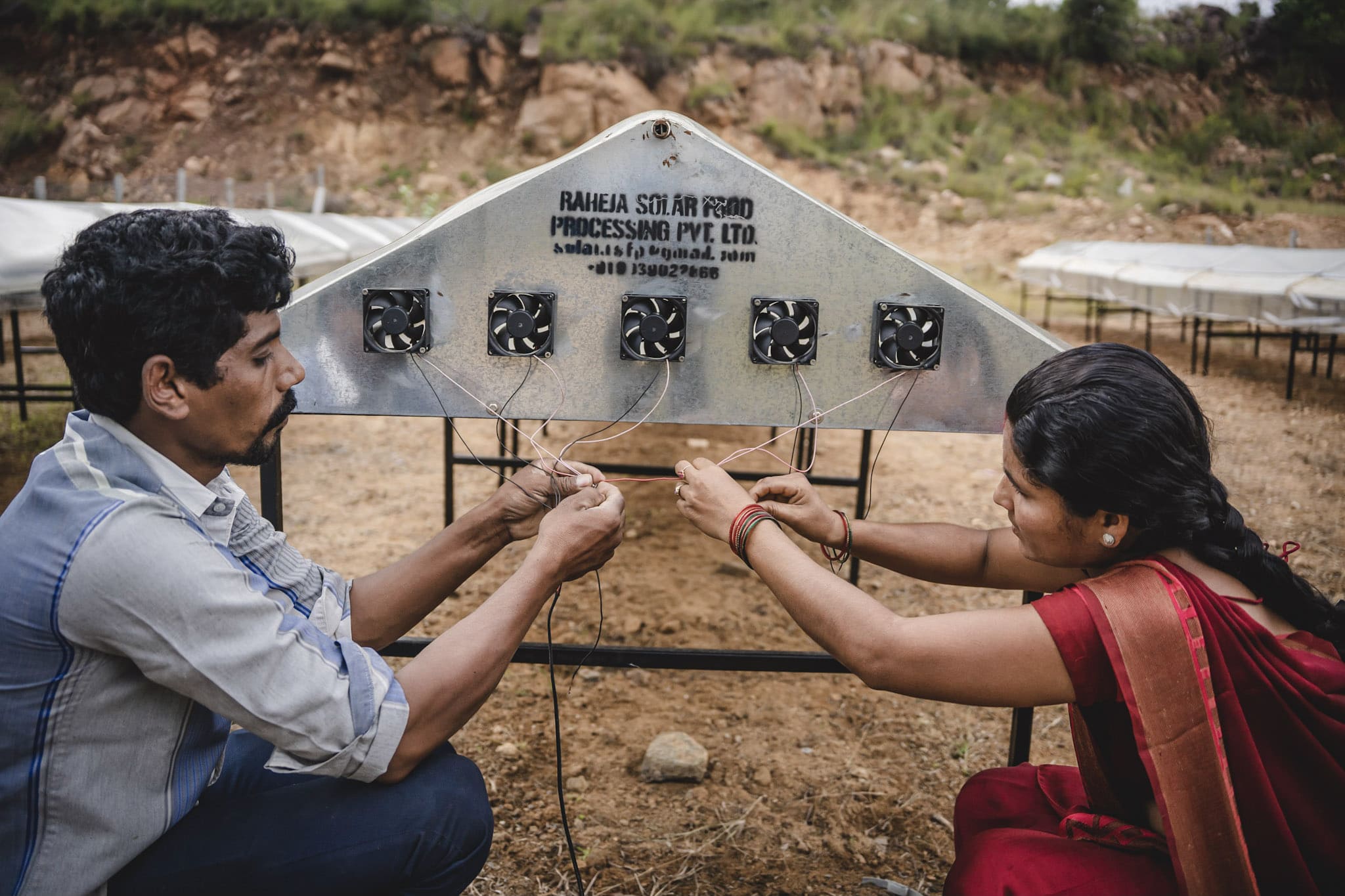
Image: Emotive Lens/CEEW
Secondly, the variety of financial structuring should be increased so that public funding can attract larger volumes of private finance. Clean air does not have a direct financial return, so private sector finance is unlikely to be sufficient relative to the economic cost of pollution. Ambient air quality “returns” are more economically and socially valuable than can currently be captured directly via private financial returns. Still, private finance for air quality actions across energy, transport, agriculture, waste, and other sectors is possible because these may deliver financial co-benefits beyond clean air.
Combining public and private sources of finance effectively will be important to fund large-scale investment in updating energy, transport, waste management, agriculture and more. Government adoption of regulatory and policy frameworks that reward investment and penalise polluting behaviour is a critical enabler of the right kinds of finance.
3. Not just about money
Finance is a key contributor to cleaner air — but technological innovation, data and analytics, policy innovation, and intergovernmental collaboration are also critical factors in success.
Levels and sources of pollution vary across seasons and geographies. The broad strategies for reducing extreme pollution can often be determined without additional data — repurposing fossil fuel subsidies and investment in clean energy, clean transport, reducing waste and agricultural burning go far.
However, achieving safe air will require localised strategies based on monitoring, modelling, and emissions inventories. Reinforcing and rewarding the investments that produce cleaner air will require more effective monitoring, reporting, and verification systems. Generating, validating, and compiling information, in turn, requires investment.
Meanwhile, while technical solutions for many sources of pollution exist, they need to be operationalised through financial and capacity building support. The specific strategies for accelerating technology diffusion vary across geographies and require diverse financing strategies. This may mean coupling finance with capacity building and developing ways to channel air quality funding to new sets of stakeholders such as subnational governments or sectoral agencies.
Support for collaboration across levels of government, sectoral agencies, jurisdictions, and public and private efforts will be important.
A three-step strategy to unlock quality financing
We don’t just need more money to improve the air, we need it to be good quality finance — namely explicit, measurable, innovative, and additional. This paper proposes a three-step plan for how to achieve this. In summary, all stakeholders should:
i. Make clean air a development finance priority: make the case for clean air as an asset
ii. Develop metrics for accountability: develop clear, shared metrics to reward investment
iii. Use existing funds for clean air more smartly and create targeted financing facilities: create dedicated pillars of financing for clean air within existing resources and establish targeted clean air financing entities for specific ‘hard to fund’ purposes.
Step 1: Make clean air a development finance priority
Having clean air as an explicitly stated objective for development finance could drive more recognition for institutions that currently invest in clean air. It could help internal clean air champions at development and impact finance entities justify investments in air quality and encourage innovation. And it could boost support by making clean air part of bigger goals – such as a “liveable planet” or “sustainable development”.
Ways to elevate clean air as an objective include referencing clean air in mission statements; creating offices or divisions within Multilateral Development Banks with a mandate to focus on clean air; ensuring that clean air is more widely recognised as critical for achieving many Sustainable Development Goals; and considering air quality in new country strategies.
There are some important principles and considerations that will help successfully embed this agenda in the international finance system. They are as follows:
Align with climate finance and emphasise co-benefits
Rather than competing for money, clean air advocates should make the case that financing clean air actions nearly always advances both climate mitigation and adaptation. Reducing air pollution, especially particulate matter and ground level ozone reduction, often mitigates climate-damaging emissions as well. It advances adaptation because it improves health, a key basis for resilience.
Given the enormous, short- and long-term economic, security and justice benefits of improved health and well-being, it makes sense that climate actions should be appreciated for the health benefits they drive. When evaluating new technologies and processes and products, and the development of climate action plans, carbon accounting should not be the sole measure of success.
The merger of carbon and health accounting in carbon credit markets, in the evaluation of all climate plans, and in public and private projects/investment decision-making could help drive momentum as human beings begin to feel the benefits of climate actions and investments. Broader efforts to measure, evaluate and account for externalities including carbon should be extended to negative impacts of air pollution.
It is key to affirm that cleaner air is not necessarily an “additional” area to invest in, rather a pathway toward achieving multiple benefits for health, climate, biodiversity, economic development, equity, food security, and more. This approach aligns with advocacy for the SDGs and should drive collaboration and cooperation rather than competition.
Make air quality a priority for key fund replenishment
The Global Environment Facility (GEF), a multilateral fund to address biodiversity loss, climate change, and pollution will be replenished in 2026. GEF priorities follow international priorities and changes in international environmental regimes. The 8th replenishment in 2022 (GEF-8), for example, includes action on plastic pollution as a priority – slightly behind, but aligned with the initiation of process toward a legally binding agreement to reduce plastics pollution.
With the series of statements and calls for action on air pollution that have and will come from United Nations Environment Assemblies, a logical outcome could be to create an integrated air quality financing initiative within GEF-9.5
Leverage the State of Global Air Quality Funding report
The Clean Air Fund’s annual report on public and philanthropic funding for clean air could be used to benchmark individual multilateral development bank efforts. The Asian Development Bank is currently a leading clean air funder, for instance.
A ranking of multilateral and regional development banks on their efforts to finance clean air action could inspire other development finance institutions to boost their investments in air quality as well.
Learn from other attempts to direct finance to under-recognised needs
There are precedents for directing money to neglected issues. For example, the Cities Climate Finance Leadership Alliance, seeks to increase the volume and share of urban climate finance by: a) improving urban focus in strategy, coordination, and tracking; b) adapting operational models to include capacity building and attention to policy/pipeline in addition to finance; c) sharpening focus on private capital mobilisation; and d) promoting an enabling national policy environment.
These components map to our focus on metrics, adapting operational models to include support beyond finance, and attention to the larger policy environment including international regimes and accountability.
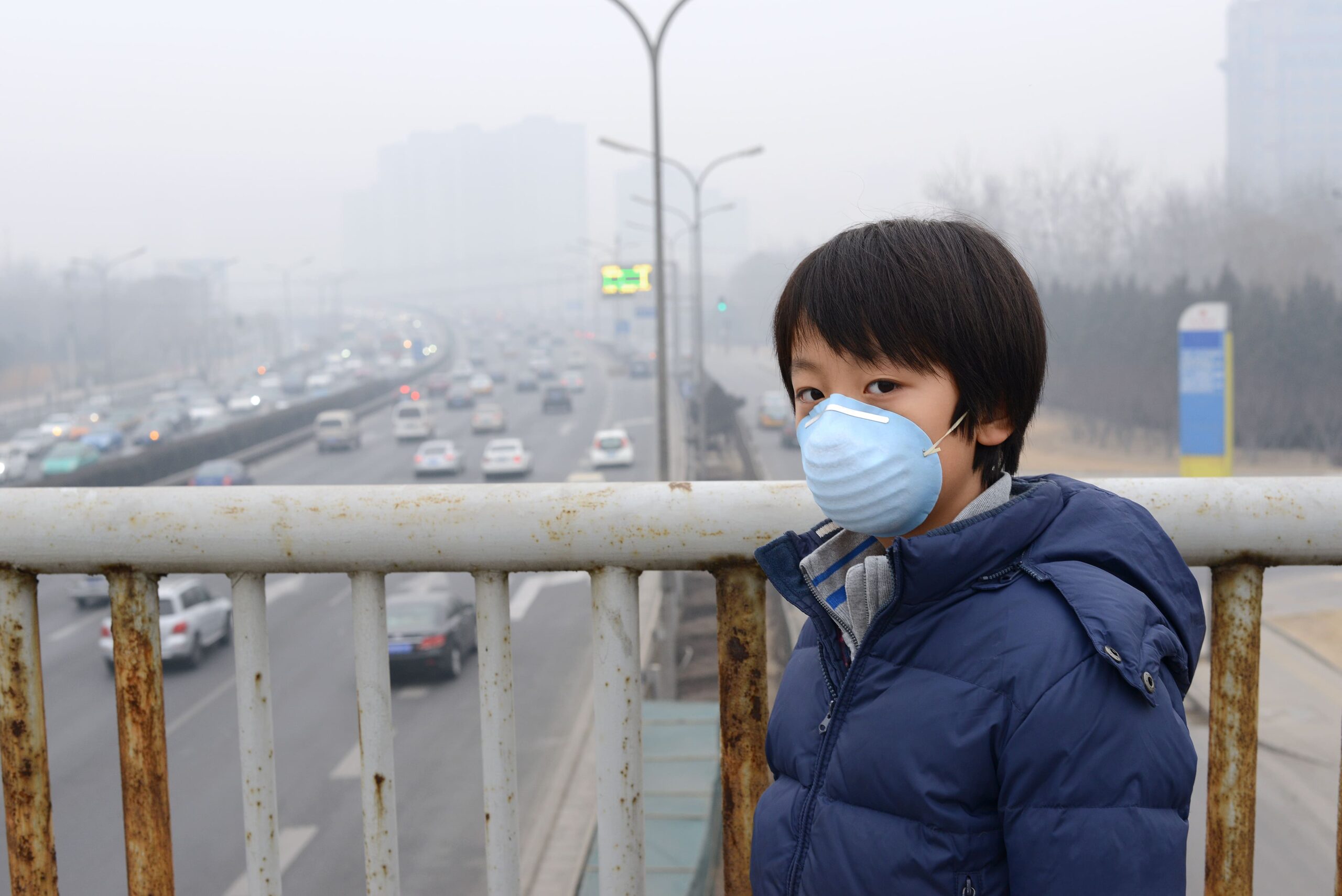
Image: iStock
Step 2: Develop metrics for accountability
Having metrics that conform to standard development finance impact tracking makes it easier for institutions to recognize impacts on clean air and incorporate it into project goals. As more organisations adopt the metrics, their efforts become comparable, enhancing competition and accountability.
Similarly, requiring health impacts of carbon reduction strategies to be tracked makes these aspects of climate mitigation efforts more visible for motivating and learning. Better metrics would enable outcome-based finance or sustainability-linked loans that are disbursed on concessional terms based on air pollution improvements.
MDBs and other stakeholders should compile clean air metrics in existing use and identify commonalities, overlaps, and conflicts in metrics and underlying methodologies to work toward acceptable, implementable common metrics across development finance institutions (DFIs).
They should work with lead adopters such as the World Bank Group (as part of its updated mission) or the Asian Development Bank (a leading funder of clean air projects) to demonstrate use and value of metrics; and work with carbon accounting frameworks to ensure that reporting includes the health impacts of the strategies for carbon savings.
Standardised metrics are important for enabling investments in clean air to be identifiable and evaluable across programs and institutions at a system-wide level. Having metrics that adequately capture changes in air quality outcomes, emissions, and/or policy effort, but that are also cost-effective to measure, will ensure wider use among projects and institutions.
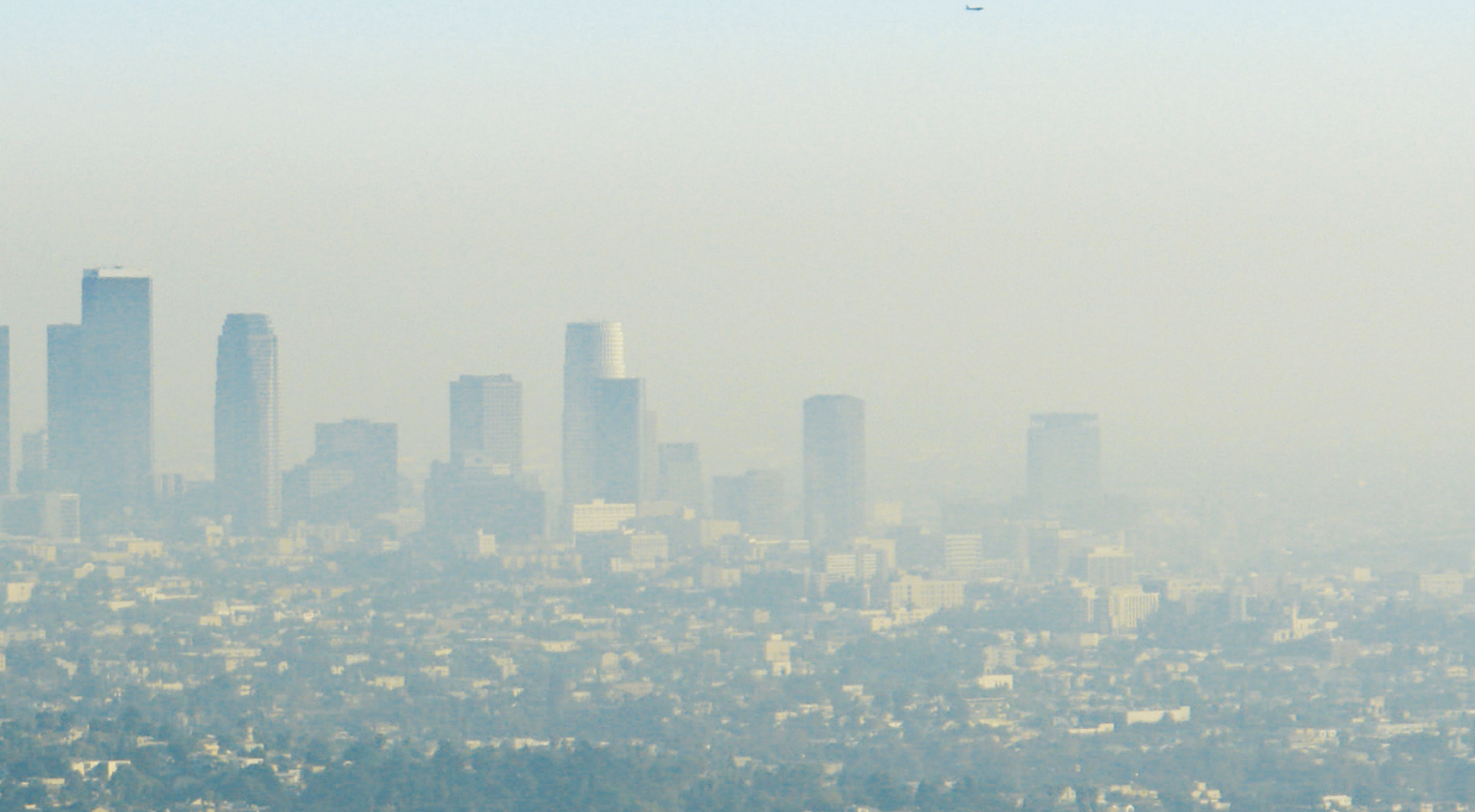
Image: Gulshan Khan/Climate Visuals
Developing such metrics will require consultation and collaboration across development finance institutions, project leaders, and data and science experts to ensure they are accurate, cost-effective, and compatible with broader monitoring, evaluation, and learning systems. There would need to be a consultative process among both communities interested in clean air and users of metrics.
Health, climate, and ecosystem communities have different ways of describing the state of the air. While all use ambient concentrations of pollution to some extent, health communities are more interested in the duration, maximum, and average exposures (depending on the pollutant). Climate communities may be interested in a region or source of pollution to estimate climate impacts given the varying effects of aerosols. And actors focused on ecosystem health monitor different relationships between pollution intensity and environmental damage. Bringing these communities together to identify a common set of metrics that would help link cleaner air to multiple benefits would be an important part of the process.
Similarly, development finance institutions have different systems for using metrics and any “widely applicable” approach would need to be compatible with their standard ways of describing the metric and the way it is calculated. Ensuring users have confidence in the data especially when used for institutional, inter-country, and regional comparisons, will be key.
The feasibility and cost of using the metric for project- or portfolio-level investments should be considered: an outcome-based metric, of project impact on air quality in a given place, would be challenging to implement for much of the world.
Step 3: Use existing funds for clean air more smartly and create targeted financing facilities
To effectively achieve and maintain clean air, we need smarter investment as well as extra funding. A better allocation of financing from within the existing budgets of financing institutions could leverage air quality to deliver multiple health, climate, economic, and developmental co-benefits. This includes supporting countries to use domestic financing, as national budgets provide funding that can be readily linked to incentives and capacity building within sectoral and regulatory policies. Removing fossil fuel subsidies and repurposing funds to invest in clean industry and infrastructure is one critical pathway.
Establishing dedicated envelopes of finance within existing MDB/RDB structures can secure institutional attention and accelerate programming, while new clean air finance entities could leverage and integrate additional financial and capacity-building support from multiple public and private sources to address specific barriers, challenges and gaps not covered by other programmes.
This twin approach is designed to leverage and integrate financial and capacity-building support from multiple public and private sources. Innovative financial structures are as important as simply “more” finance.
Establishing an entirely new entity may be risky given the competing demands for finance for environmental, development, and climate goals. However, there are growing calls for reforming the structure and complexity of multilateral development finance that may help gather wide support for an air quality facility as a demonstration “test bed” for a broader class of new financial forms.
That said, it is important to work within existing MDB structures including updates stemming from ongoing reform, before creating new entities. The experience of creating an entirely new Pandemic Fund is illustrative. The fund was launched in November 2022 on the sidelines of the G20 Joint Finance and Health Ministers’ Meeting. It was meant to strengthen low- and middle-income countries’ capacity to mitigate the risks of future global health threats through funding and technical assistance.
However, it has been challenging to raise additional funds for this specific vehicle and capitalisation remains modest relative to the needs. It is also not clear if the new funding will flow beyond the usual areas in which the World Bank invests to cover, for example, new regional and public goods or investments in developing and manufacturing pandemic countermeasures.
As such, any new clean-air focused entities should be developed based on deeper analysis of current barriers to financing air pollution reducing technologies, infrastructure, and services. Such entities could help channel such funds to integrated, evidence-based clean air action from city to multi-national and regional levels.
A stated priority for clean air may also help motivate demand for funds: stakeholders seeking clean air investments may not ask for funds that they do not think will be prioritised.
Ways of successfully ensuring existing finance drives cleaner air, and designing effective new funds include:
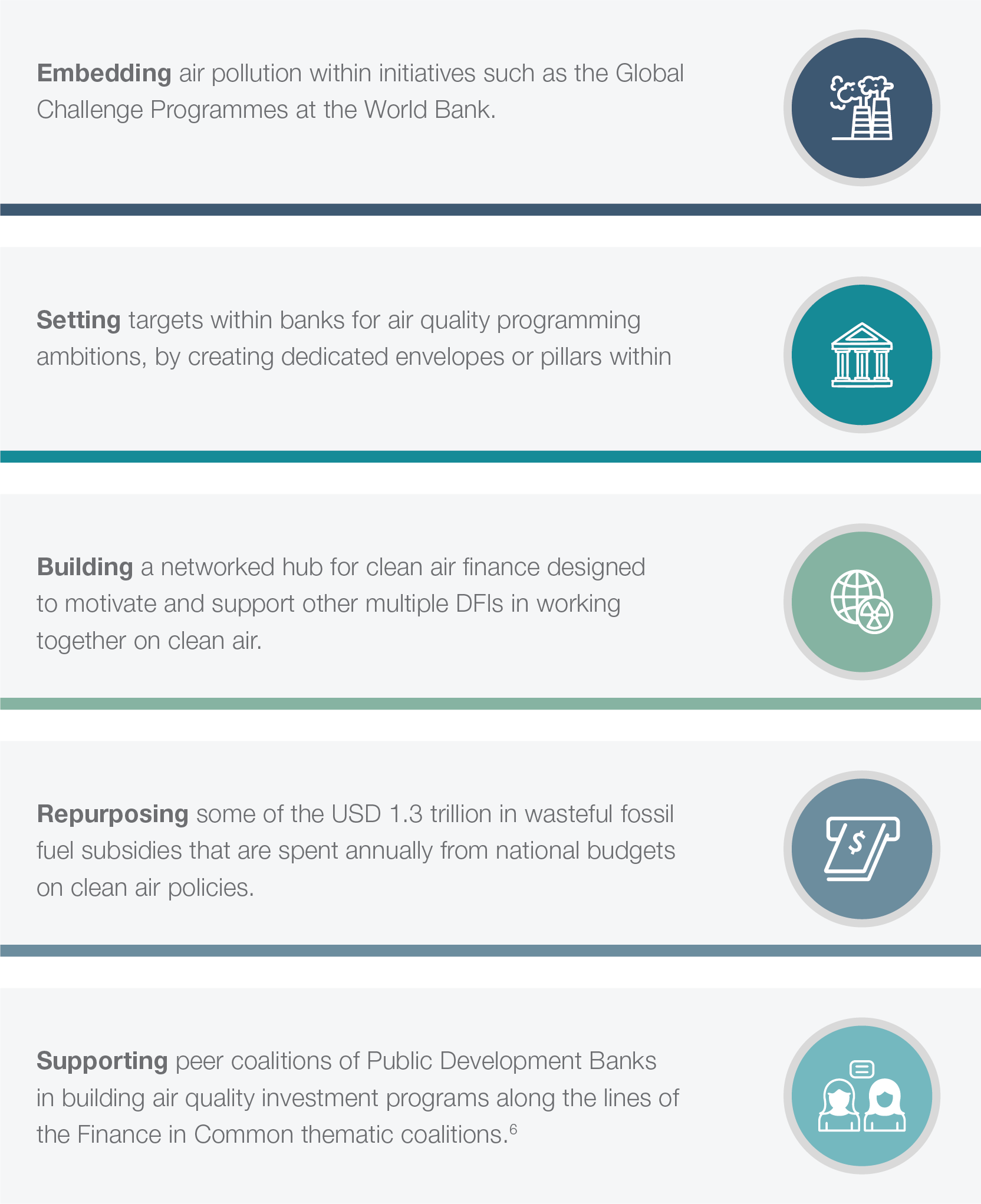
Who and what needs financing
Multiple levels of government will require finance for making the necessary changes in energy, transport, waste, and other systems to reduce emissions:
Cities are important leaders in air quality. They tend to be more motivated than national governments, they generate a substantial portion of emissions and, as population centres, they are the places where much of the exposure and health impacts happen. But they cannot clean up the air alone: pollution comes from outside their boundaries, and cities often have neither the policy authority nor access to centrally controlled finance to reduce emissions within their boundaries.
National governments are essential. Within national government, environmental and regulatory agencies may need support, but also sectoral ministries that shape emissions from polluting sectors. This includes tax/revenue sharing formulae/incentives in federal jurisdictions, such as were adopted by India via its Fifteenth Finance Commission.
Given the movement of air across national boundaries, regional entities could be important actors in some areas, for example in South and Southeast Asia and Africa. These entities exist but have uneven capacity to act – flows of finance to initiatives like the Acid Deposition Monitoring Network for East Asia (EANet) or the Regional Intergovernmental Network on Air Pollution for Latin America and the Caribbean may be important, particularly in the context of efforts to call attention to and strengthen capacity among regional initiatives.7
The Africa Center for Disease Control and Prevention is well placed at the nexus of regional political mandate, technical capacity for estimating and formulating policies to reduce air pollution as a public health threat, and providing technical support for country-level actions.8
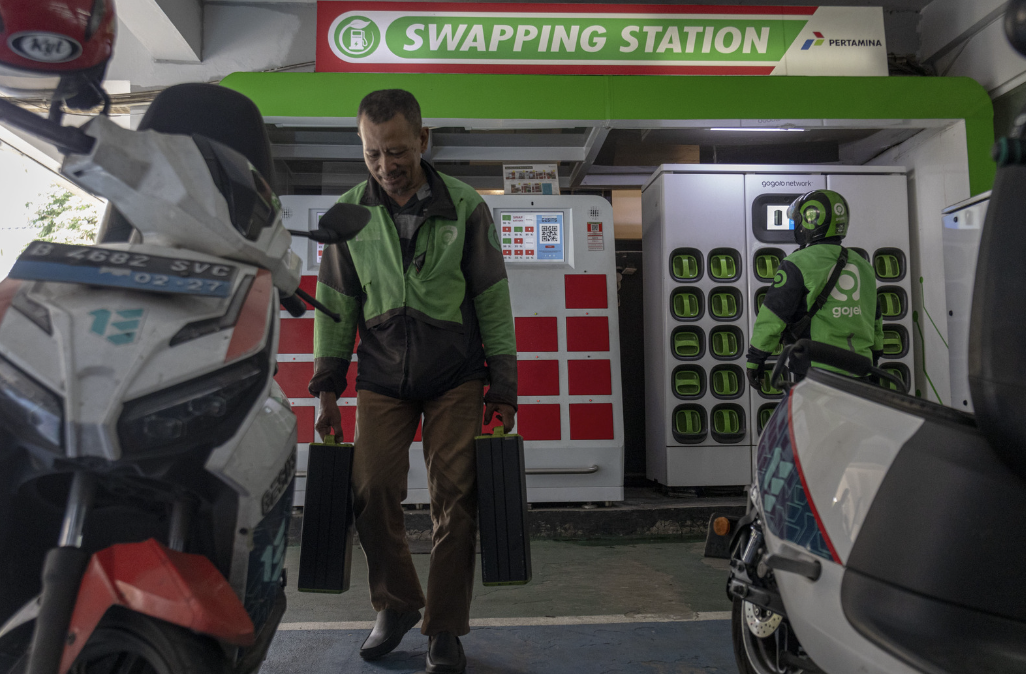
Image: Aji Styawan/Climate Visual
Some examples of entities to be financed
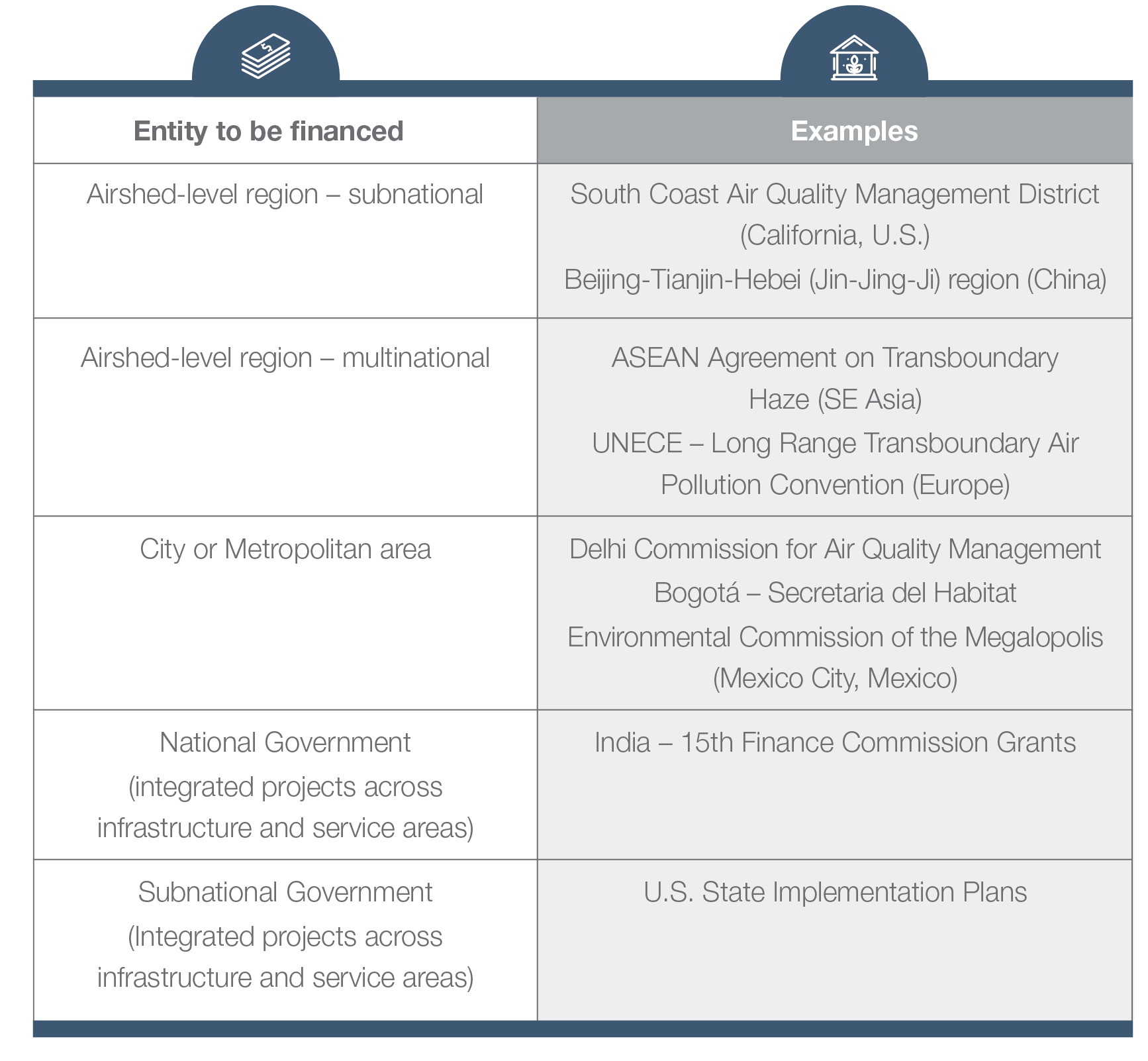
What needs to be financed?
‘Air quality action’ includes several potential financing needs. This means that facilities need to be able to access and disburse capacity-building support as well as money. These are some of the activities that need financing:
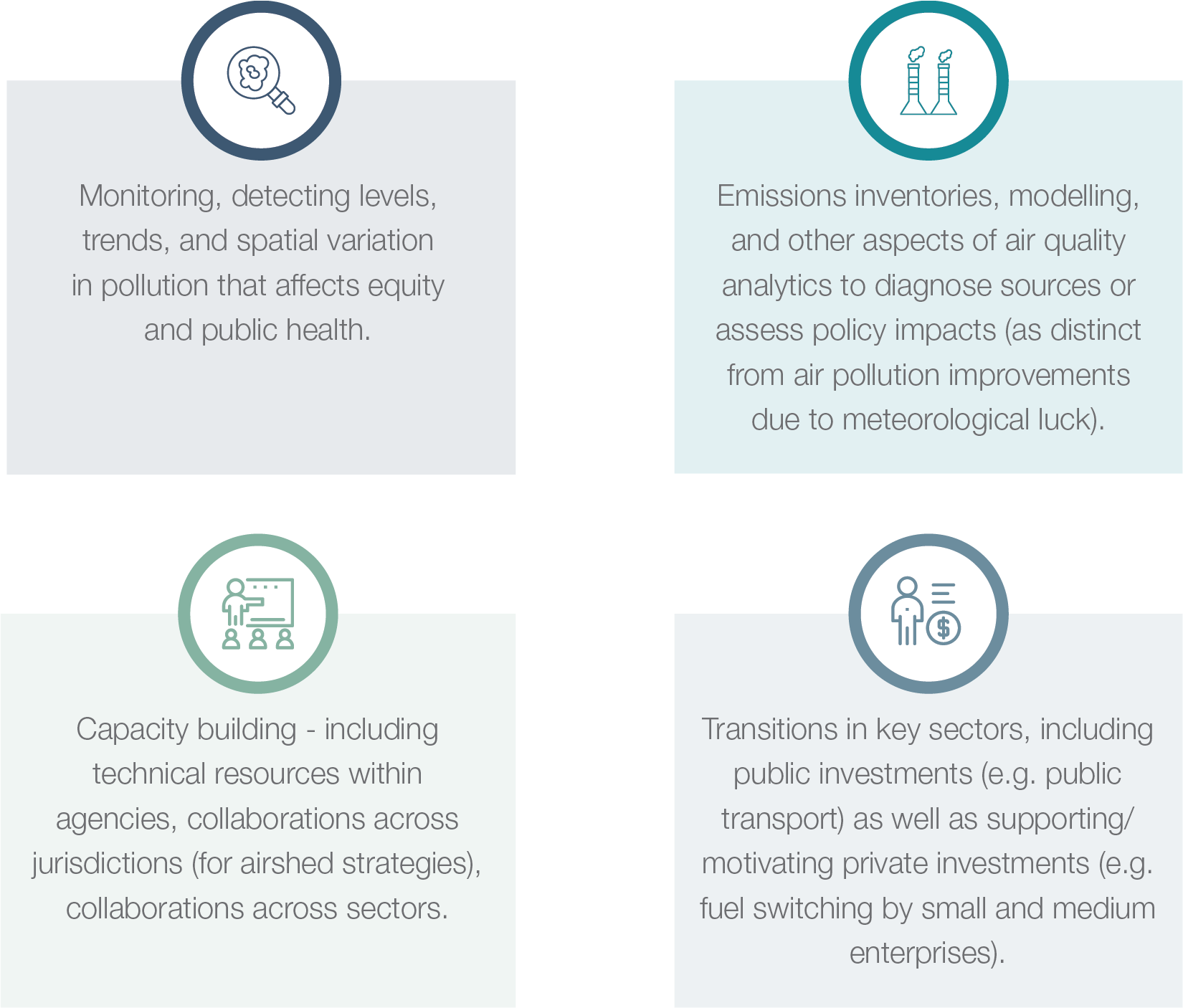
There are several economic, environmental, and financial returns on clean air that could be used to motivate investments from different public and private sources.9 Accordingly, air quality financing facilities need to be able to integrate and structure finance with a range of risk and return preferences.
Precedents – what can we learn from others
As we develop air quality financing mechanisms there is much to learn from other issue areas that have similar structural requirements. Road safety, for example, is a locally salient goal, affected by various types of investments in services (traffic management) as well as infrastructure (road design) that are determined based on factors other than safety.
Improving road safety requires coordination across agencies as well as between levels of government in addition to private investments and behaviour change. Some of the structures that national governments have set up to deliver funds to local governments and regions may be relevant for air pollution planning.
The examples below include structures developed for issue areas that most would recognise as similar to and/or overlapping with air quality.
Example 1. MDB financing “envelopes”
At COP28, the World Bank showcased its country-level programming to drive synergies between climate change and air quality management including in Bangladesh and China. Several features stood out which could be “good practices” for other institutions to embed.
- The Bank convened leaders across neighbouring geographies to develop collaborative approaches to reducing emissions.
- Individual country strategies were:
- Deeply embedded in sectoral policies, included innovation to develop localised solutions, and the micro-level incentives for adoption of existing technologies.
- Carrots and sticks were used — incentives and the traditional powers of environment ministries, but also fiscal support and public finance for alternatives.
- Public support was cultivated for changes by tracking health and other gains from cleaner air resulting from investments.
Example 2. Prior Global Environment Facility (GEF) initiatives
GEF-funded structures such as the Global Platform on Sustainable Cities (GEF-6) and UrbanShift (GEF-7) are imperfect but interesting structures for combining capacity-building and design support for integrated projects at the city-to-metropolitan levels to meet environmental goals.
Under GEF-6 and GEF-7, the sustainable city programme was launched with a clear purpose of providing city governments with grant resources for technical expertise to help them design sustainable planning. The idea was to move out of a sectoral / project by project approach to a programmatic approach focusing on design.
In addition to the implementing Agency (World Bank for GEF6 and UNEP for GEF7), city-focused organisations, namely World Resources Institute, C40, and ICLEI served as a technical team. The Secretariat — anchor plus technical teams — worked with multiple multilateral development banks to help cities identify and prepare integrated projects to be funded by a variety of other multilateral development banks.
These types of programmes could be models for a GEF-9 initiative or another integrative financing effort beyond the GEF structure. This is in line with broader calls for multilateral development finance reform to work more effectively as a “system” across MDBs.10
Conclusion and recommendations
Air quality funding needs are big and largely unmet – at the global, national and local level. At the same time, the actions needed to drive air quality are the same as many needed to mitigate climate change or improve health. Identifying these co-benefits and ensuring improving the air is a stated objective of existing funding is one way to ensure the potential benefits are realised.
Separately, smarter financing through better use of existing funds and targeted deployment of new financing that is properly aligned with other initiatives will be an important part of the solution. In keeping with an approach that seeks systematic shifts and transformations, we urge all stakeholders in the broader finance ecosystem to work together to implement our recommendations.
While each recommendation is targeted at a specific audience, their implementation will not happen without those in the wider clean air and finance community galvanising action. The examples below include structures developed for issue areas that most would recognise as similar to and/or overlapping with air quality.
1. All public development banks, including multilateral, regional and national development banks
As criteria for project selection, develop and adopt a strong, agreed, universal system of metrics, that will ensure air quality impacts are encouraged, tracked and publicised across investment portfolios.
Specific associated measures could include adding air quality objectives to sectoral finance initiatives, e.g. for buildings, transport, infrastructure.
Create dedicated pillars or programmes for air quality in financing envelopes and incorporate criteria to promote the funding of air quality initiatives through new mechanisms, such as the World Bank Global Challenge programmes.
Support local banks to play a critical role in developing and implementing financial support schemes to help households and small enterprises to adopt cleaner solutions and to mobilise private capital.
2. The wider funder community, including governments and philanthropy, as well as the public development banks
Create targeted clean air financing facilities for hard to fund purposes that will a) leverage and integrate additional financial and capacity-building support from multiple public and private sources to address specific barriers, challenges and gaps; and b) build the pathways to channel such funds to integrated, evidence-based clean air action from city to multi-national and regional levels.
3. All stakeholders engaging with the multilateral and regional development banks, including government board members, civil society and creditors.
Leverage ongoing reforms in the international financial architecture to ensure that development banks give air quality due attention as an investment in health, climate and sustainable economic development.
Demand that development banks invest in project preparation facilities for clean air projects to overcome capacity barriers, and that they increase the proportion of grant and concessionary funding to improve the uptake of financing.
Press development banks and national authorities to work together to extend financing to city, local government and state authorities that accelerates action on air pollution.
Encourage development banks to incorporate air quality goals into country strategies, develop projects required to achieve them, and use blended finance instruments to combine different sources and capabilities of finance including commercial banks, private sector and philanthropies.
4. Climate finance providers
Recognise that climate adaptation financing to build resilience and reduce risk must include air quality considerations in its planning. Examples include wildfire management and efforts to reduce black carbon deposition on snow and ice.
5. Strategic philanthropy
Recognise the role of philanthropy in catalysing clean air programmes at the local level, in the form of low-cost monitoring infrastructure and laboratories for piloting programmatic and sectoral interventions.
Recognise and support their role in making the transition more sustainable by working with a broader community without significantly increasing the debt burden of local governments.
6. Private sector companies
Demonstrate the business value of clean air by accepting responsibility to monitor, report and reduce corporate air pollution along the value chain.
Invest in clean air solutions, including energy transition technology, demonstrating the business case for tackling air pollution.
Champion action on air pollution with stakeholders, including employees, customers, suppliers, and governments.
7. Government regulators, agencies and ministries
Ensure that the true costs of imposing air pollution on economies are measured, evaluated, accounted for, and borne by polluters, public and private, through a responsible regulatory regime that encourages transparency from pollution sources, cleaner business practices, and which rewards efforts to reduce air pollution footprints.
For smaller, dispersed sources, such as farmers, households and small enterprises, provide the technical and financial support and guidance needed to help them switch to less emitting technologies and practices.
8. Participants in Carbon Accounting
We call on investors in carbon emissions reduction, and the authors of accounting frameworks for carbon to document health impacts of carbon reduction efforts alongside the carbon accounting.
9. National Governments
Redirect their current fossil-fuel enabling subsidies toward clean air outcomes. Develop national and subnational plans and targets to tackle air pollution and provide policy and financing incentives to achieve them.
Endnotes
1 Strinati, Costanza, Sean Stout, Jake Connolly, Léa Faucheux and George Tsitati. 2023. The State of Global Air Quality Funding 2023. Clean Air Fund. https://www.climatepolicyinitiative.org/publication/the-state-of-global-air-quality-funding-2023/
2 Ibid
3 Ibid
4 Ibid
5 United Nations Environment Program. 2024. “United Nations Environment Assembly”. United Nations Environment Assembly. Last modified April 10, 2024. https://www.unep.org/environmentassembly/
6 Finance in Common. 2024. “What We Do”. Last modified April 10, 2024. https://financeincommon.org/#what-we-do
7 United Nations. 2024. Draft resolution on promoting regional cooperation on air pollution to improve air quality globally. Nairobi: United Nations Environment Programme. https://www.unep.org/environmentassembly/unea6/outcomes
8 Africa Centers for Disease Control and Prevention. n.d. “About Us”. https://africacdc.org/about-us
9 Economic returns = broad social returns, not necessarily appropriate-able by any particular entity. Environmental returns = climate mitigation, biodiversity protection, health. These can be represented in economic terms, but have distinct recognised value. Financial returns = returns that accrue to a particular individual, business, organisation, etc
10 For example: The 2023 G20 Report of the Independent Expert Group on Multilateral Development Finance – “The Triple Agenda,” notes that “Achieving [the shared objective of transformation of client countries] requires better coordination among MDBs. They can work better as a system through joint financing and risk-sharing, jointly improving the ecosystem of project pipeline development, regulatory and institutional reform, and information exchange,…” (14) [emphasis added]
Latest Publications
11 April 2024
Clean Air: A Call to Action
This Call to Action is focused on making the economic case for clean air, financing the investments needed, setting targets and tracking progress, and sharing solutions.
Our Common Air
